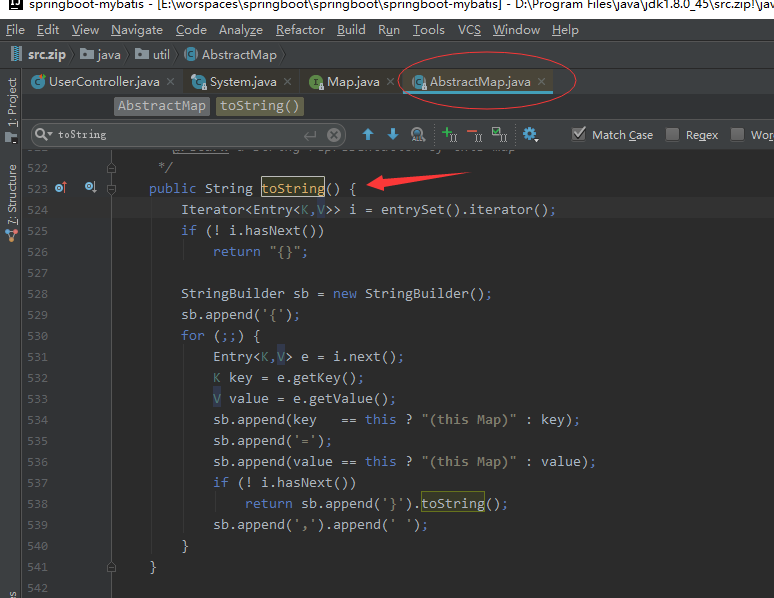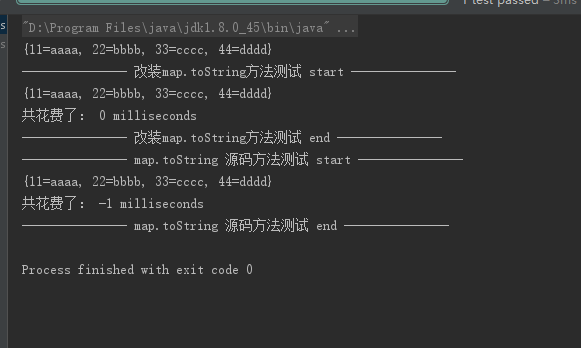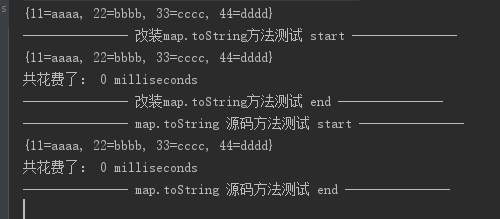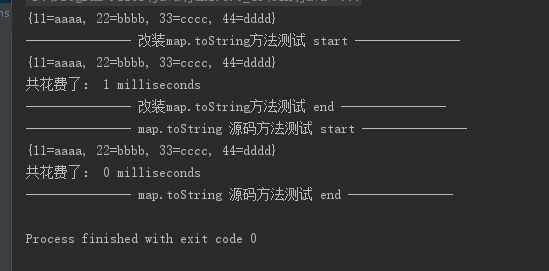?
? ? 1. 编写一个单元测试类
? ? ? ??
? ? ? ??
class="java"> @Test
public void tt() {
Map<Object, Object> map = new HashMap<>();
map.put("11", "aaaa");
map.put("22", "bbbb");
map.put("33", "cccc");
map.put("44", "dddd");
System.out.println(map);
System.out.println("--------------- 改装map.toString方法测试 start ---------------");
long btime1 = System.currentTimeMillis();
String str = toString2(map);
System.out.println(str);
long etime1 = System.currentTimeMillis();
System.out.println("共花费了: "+(etime1-btime1) + " milliseconds");
System.out.println("--------------- 改装map.toString方法测试 end ---------------");
System.out.println("--------------- map.toString 源码方法测试 start ---------------");
long etime2 = System.currentTimeMillis();
String str2 = toString3(map);
System.out.println(str2);
long btime2 = System.currentTimeMillis();
System.out.println("共花费了: "+(etime2-btime2) + " milliseconds");
System.out.println("--------------- map.toString 源码方法测试 end ---------------");
}
?
?
? 2.通过源码我们找到了代码实现(如下:)
?
??
?
? ?通过源码解读,我们可以知道,map.toString()方法主要是
?
? ? 通过map的迭代器判断集合是否有值,如果没有值就直接返回,如果有值我们就通过for(;;) 死循环 和?
?
? ?StringBuilder (不需要考虑线程安全问题, 并且考虑到效率,所以使用StringBuilder 不使用StringBuffer)
?
? 字符串缓冲区的拼接,最后加一个判断,当游标遍历到最后一个说明没有值了,直接返回字符串数据.
?
? 4 思考:于是看到这里,我们就去想源码拿出来 ? ?再把for(;;) 死循环 换成 while(true)进行测试
?
(最终代码实现)
?
??
@Test
public void tt() {
Map<Object, Object> map = new HashMap<>();
map.put("11", "aaaa");
map.put("22", "bbbb");
map.put("33", "cccc");
map.put("44", "dddd");
System.out.println(map);
System.out.println("--------------- 改装map.toString方法测试 start ---------------");
long btime1 = System.currentTimeMillis();
String str = toString2(map);
System.out.println(str);
long etime1 = System.currentTimeMillis();
System.out.println("共花费了: "+(etime1-btime1) + " milliseconds");
System.out.println("--------------- 改装map.toString方法测试 end ---------------");
System.out.println("--------------- map.toString 源码方法测试 start ---------------");
long etime2 = System.currentTimeMillis();
String str2 = toString3(map);
System.out.println(str2);
long btime2 = System.currentTimeMillis();
System.out.println("共花费了: "+(etime2-btime2) + " milliseconds");
System.out.println("--------------- map.toString 源码方法测试 end ---------------");
}
public String toString2(Map<Object, Object> map) {
Iterator<Map.Entry<Object, Object>> i = map.entrySet().iterator();
if (!i.hasNext()) return "{}";
StringBuilder sb = new StringBuilder();
sb.append('{');
while (true) {
Map.Entry<Object, Object> e = i.next();
Object key = e.getKey();
Object value = e.getValue();
sb.append(key == this ? "(this Map)" : key);
sb.append('=');
sb.append(value == this ? "(this Map)" : value);
if (!i.hasNext()) return sb.append('}').toString();
sb.append(',').append(' ');
}
}
/**
* @param map
* @return
*/
public String toString3(Map<Object, Object> map) {
Iterator<Map.Entry<Object, Object>> i = map.entrySet().iterator();
if (!i.hasNext())
return "{}";
StringBuilder sb = new StringBuilder();
sb.append('{');
for (; ; ) {
Map.Entry<Object, Object> e = i.next();
Object key = e.getKey();
Object value = e.getValue();
sb.append(key == this ? "(this Map)" : key);
sb.append('=');
sb.append(value == this ? "(this Map)" : value);
if (!i.hasNext())
return sb.append('}').toString();
sb.append(',').append(' ');
}
}
?
? 5.测试结果如下:
?
??
?
?
? ?
?
?
?
??
?
? ?测试结果:失败 ? ? ? ? ? ? ? ? ? ? ? ? ? ? ? ? ? ? ? ? ? ? ? ? ? ? ? ? ? ? ? ? ? ? ? ? ? ? ? ? ? ? ? ? ? ? ? ? ? ? ? ? ? ? ? ? ? ? ? ? ? ? ? ? ? ? ? ? ? ? ? ? ?
? ?总结: ?(1) map.toString ?是通过 迭代器 ?和 StringBuilder(字符串缓冲区) ?和 ?for(;;) 死循环实现的;
? ?
? ? ? ? ? ? ? (2) for(;;) 死循环的效率 比 ?white(true) 死循环的效率高;
?
?
?
?
?
?
?
?
?
?
?
?
?
?
??
?
? ?
?
? ?
?